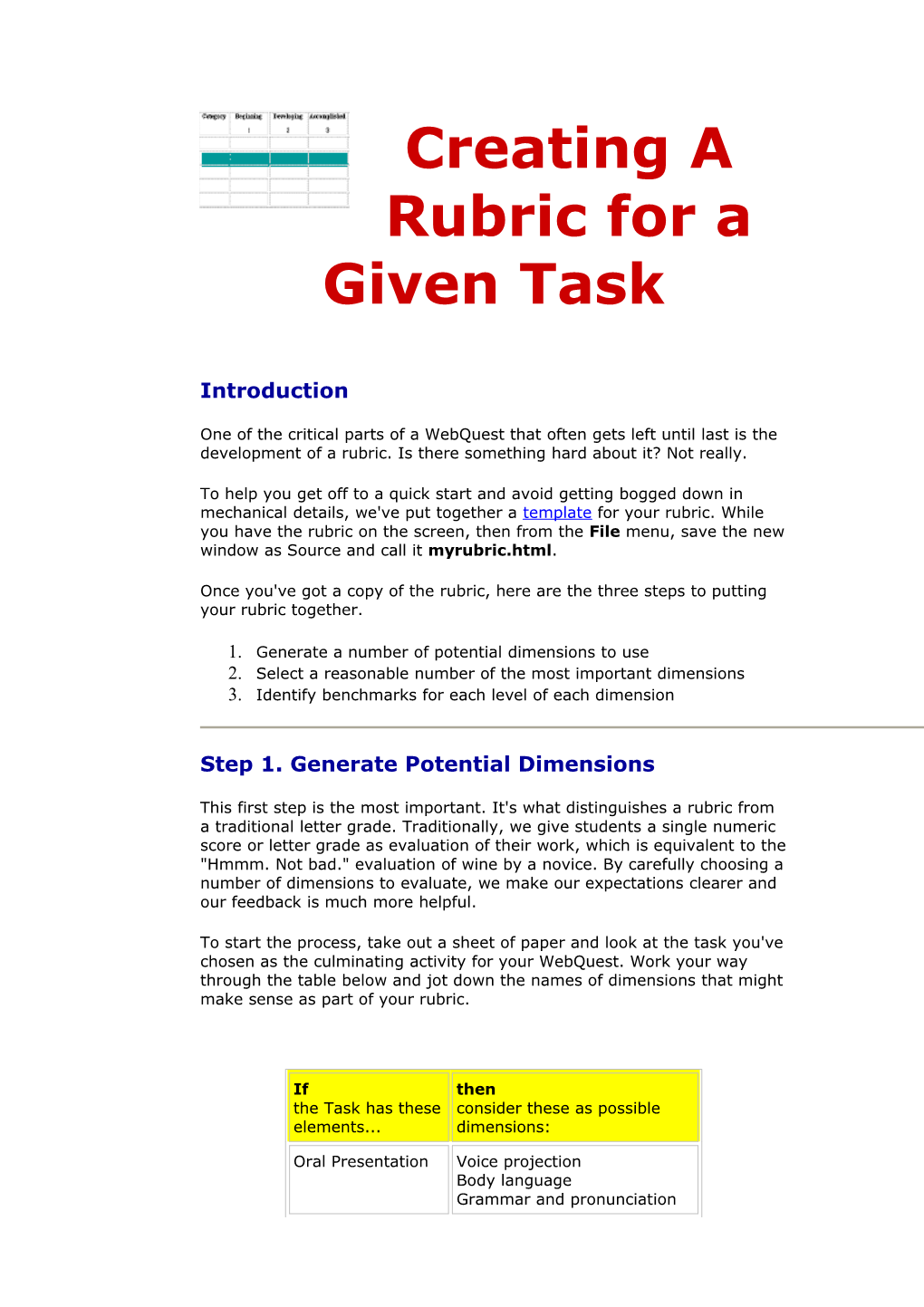Creating A Rubric for a Given Task
Introduction
One of the critical parts of a WebQuest that often gets left until last is the development of a rubric. Is there something hard about it? Not really.
To help you get off to a quick start and avoid getting bogged down in mechanical details, we've put together a template for your rubric. While you have the rubric on the screen, then from the File menu, save the new window as Source and call it myrubric.html.
Once you've got a copy of the rubric, here are the three steps to putting your rubric together.
1. Generate a number of potential dimensions to use
2. Select a reasonable number of the most important dimensions
3. Identify benchmarks for each level of each dimension
Step 1. Generate Potential Dimensions
This first step is the most important. It's what distinguishes a rubric from a traditional letter grade. Traditionally, we give students a single numeric score or letter grade as evaluation of their work, which is equivalent to the "Hmmm. Not bad." evaluation of wine by a novice. By carefully choosing a number of dimensions to evaluate, we make our expectations clearer and our feedback is much more helpful.
To start the process, take out a sheet of paper and look at the task you've chosen as the culminating activity for your WebQuest. Work your way through the table below and jot down the names of dimensions that might make sense as part of your rubric.
If
the Task has these elements... / then
consider these as possible dimensions:
Oral Presentation / Voice projection
Body language
Grammar and pronunciation
Organization
PowerPoint or HyperStudio Presentation / Technical quality
Aesthetics
Grammar and spelling
Written products / Grammar and spelling
Organization
Formatting
Creative products / Surprisingness, novelty
Technical quality
Adherence to conventions of the genre
Collaboration / Cooperation
Taking responsibility
Conflict resolution
Design / Solution effectiveness
Solution creativity
Justification of solution
Persuasion / Quality of argument
Match of appeal to audience
Organization & sequence
Analysis (Scientific or otherwise) / Data gathering and analysis
Inferences made
Judgment / Adequacy of elements considered
Articulation of ranking criteria
Compilation / Selection criteria
Organization
Journalism / Accuracy
Organization
Completeness
Step 2: Select a Reasonable Number of Dimensions
In Step 1, you probably listed more dimensions than you really need, so now it's time to weed it down. How many is enough? Some recommend that your rubric should fit on one printed page. Others say that 4 to 8 dimensions is about right. There's no one correct answer, but it might help if you consider your purpose for this measurement. If it's diagnostic and formative, err on the side of more dimensions rather than fewer. If you just want to be able to give a summative evaluation of your students' performance for this particular lesson, fewer dimensions are OK.
If you need more than the five dimensions that are included in the rubric template, click in one of the rows of the table and look for a command to "Add Row" somewhere in your web editor.
Ask yourself what the most important aspects of this task are and rank your dimensions from most important to least.
Eliminate those dimensions that are at the bottom of your list until you've determined the most important 4 to 8 dimensions.
Write those remaining dimensions in the leftmost column of the rubric template.
Step 3: Write Benchmark Descriptions
Now think about each dimension. What would a superb example of each dimension look like? Describe in succintly and clearly and write each description in the rightmost column of the rubric.
What would a slightly less example look like? Fill out the next column, and so on until you've got each cell of the matrix filled.
Creating a Rubric for a Given Task
